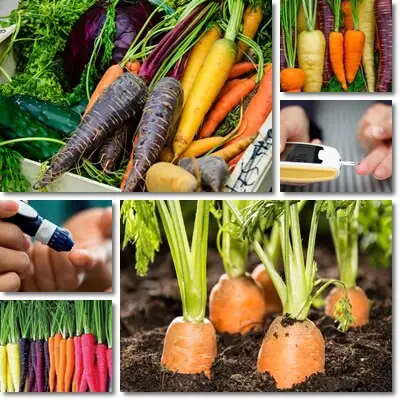Not only can you eat carrots with diabetes, it’s actually good for you and can help better manage blood glucose, or sugar levels. The only condition is that intake be limited to moderate amounts which are to be determined according to the diabetic patient’s individual nutritional requirements and the restrictions of their condition, including individual tolerance to the amount of carbohydrates in the vegetable, sugar included. Despite having a variable glycemic index (the number that predicts the extent to which a plant food will impact blood glucose levels), carrots are not likely to affect blood glucose levels too much if diabetics only eat small amounts at a time and pair them with sources of animal protein.
Surprisingly, diabetes and carrots are a relatively good pair, despite the sweet root vegetable providing almost 10 g of carbohydrates for every 100 g, close to half of which are simple sugars. Really, the carbohydrate and sugar content rivals that of fruits. And yet, the vegetable is helpful in diabetic diets and even provides some benefits such as improved blood glucose control, better insulin sensitivity, more energy and minor benefits for weight management, eyesight, skin and nervous system as well as reduce hunger and sweet cravings.

Carrots carbohydrate and sugar content differs depending on the age of the vegetable and processing undergone. On average, 100 g of raw carrots has 9.58 g of total carbohydrates, 4.74 g of which are simple sugars and 2.8 g indigestible dietary fiber (and another 2.04 g of digestible carbohydrates that are also broken down into simple sugars during digestion). Digestible carbohydrates and simple sugars are absorbed as sugar into the bloodstream and contribute to what is known as blood glucose (or sugar) levels. Indigestible carbohydrates such as dietary fiber pass undigested, untransformed through the gastrointestinal tract and do not contribute to blood glucose levels.
If the carrot variety is sweeter, it may have a higher sugar content. If the carrot is left to mature until it’s tough and woody, it may have more indigestible fiber and a less of an effect on blood glucose levels in its raw form. When cooked, the sweet root vegetable is more readily digestible and can raise blood glucose levels more than in its raw form (but the extent to which it affects blood glucose metabolism depends a lot on how much you eat). Canned or pre-cooked options may have added sugars and more of an effect on diabetics.
The extent to which the root vegetable affects blood glucose metabolism in diabetics can be estimated with the help of the glycemic index and load values. Basically, the glycemic index (GI) is a scale that predicts how fast the carbohydrates in a plant food raise blood glucose levels. Below 55 is a low GI; between 55-69 is a moderate GI and between 70-100 is a high GI. Diabetics are advised to choose plant foods with as low a GI as possible to limit effects on blood glucose levels.

Carrots glycemic index: 39 to 71 (low to high)
Carrots glycemic index varies a lot, with values ranging from as little as 39 all the way to 71. This means the root vegetable can have a low, moderate or high glycemic index, depending on the variety and its natural carbohydrate and sugar content, maturity, cooking or processing involved.
For a lower glycemic index and the least effects on diabetes, choose raw carrots over cooked ones, less sweet varieties over sweeter ones and older, woodier roots rather than younger, more tender ones. It’s better to eat carrots whole instead of pureeing them and absolutely avoid canned, pre-cooked options. It helps to limit cooking time as much as possible (for example, don’t boil them all the way – instead, allow them to retain some degree of firmness, similar to ‘pasta al dente’).
And absolutely limit serving size. This aspect is actually covered by the glycemic load (GL), a scale similar to the glycemic index (GI), but one which takes into account serving size. Basically, the glycemic load (GL) measures to what extent the carbohydrates in a given serving of food raise blood glucose levels. Below 10 is a low GL; between 11-19 is a moderate GL and over 20 is a high GL.
Now, the glycemic load is determined by dividing the glycemic index of a fruit to 100 then multiplying the resulting number to the amount of carbohydrates (grams of carbs) in a serving of a plant food. Generally, the sweet root vegetable has a glycemic load of 2-4. But even if it sometimes has a high glycemic index (in some cases over 20), if serving size is kept moderate to low, there should be minimal effects on blood glucose levels in diabetics. The lower the intake, the less pregnant the effects.
Bottom line is eating carrots is bad for diabetes type 2 and type 1 only if intake is excessive per day and per meal. Based on what your doctor estimates your maximum intake of carbohydrates per day and per meal should be, you can determine how much carrots you can eat in a day and per meal in order to keep your intake of carbohydrates below the recommended threshold. Basically, counting carbohydrate intake right makes eating carrots good for diabetes, even if they are technically a high glycemic food.
How to eat carrots with diabetes
How can diabetics eat carrots safely? Here are 7 excellent tips and tricks to make the sweet root vegetable low glycemic for diabetics and reduce its effects on blood glucose (sugar) metabolism:
1) Eat small servings. The smaller the serving, the lower the contribution to your carbohydrate intake.
2) Choose raw over cooked carrots. Cooking breaks down the bonds between carbohydrates and makes the carrot more readily digestible and higher glycemic at the same time. The raw root vegetable is harder to digest and lower glycemic.
3) Reduce cooking time. Ideally, allow the root to become somewhat soft, but retain its firmness at the same time (similar to cooking pasta al dente). This lowers glycemic values.
4) Boiling may be better than roasting and baking. Boiling allows you to reduce cooking time and, along with it, glycemic index. But absolutely avoid dehydrated carrots (100 g has 79.6 g of total carbohydrates of which 38.8 g simple sugars and 23.6 g dietary fiber and another 17.2 g of digestible carbohydrates that also turn to sugar).
5) Whole is better than mashed. When you eat a fruit or a vegetable whole by biting into it with your teeth, the entire digestion process ends up taking longer which is good if you are looking to manage your blood glucose levels. Whenever possible, choose to eat your fruits and vegetables whole. Avoid mashed or pureed fruits and vegetables which are high glycemic (pureed food is like pre-digested food).
6) Count your carbohydrates. See a doctor or a nutrition expert to learn what is a good intake of carbohydrates for you, per day and per meal. Then determine how much carbs are in what you’re eating to make sure you don’t experience spikes in blood glucose.
7) Pair with animal protein. A boiled egg, some chicken or other lean meat, a small piece of cheese or a little yogurt can help make carrots good for diabetes by reducing their glycemic index and effects on blood glucose metabolism. The protein (and small amounts of fat) in these foods slow down digestion and the rate of sugar absorption into the bloodstream.
